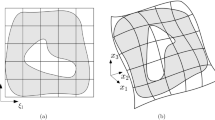Abstract
The present paper proposes a rigorous approach for the elimination of spurious kinematic modes in hybrid equilibrium elements, for three well known mesh patches. The approach is based on the identification of the dependent equations in the set of inter-element and boundary equilibrium equations of the sides involved in the spurious kinematic mode. Then the kinematic variables related to the dependent equations are reciprocally constrained and, by application of master slave elimination method, the set of inter-element equilibrium equations is reduced to full rank. The elastic solutions produced by means of the proposed approach verify the homogeneous, the inter-element and the boundary equilibrium equations. Hybrid stress formulation is developed in a rigorous mathematical setting. The results of linear elastic analysis obtained by the proposed approach and by classical displacement based method are compared for some structural examples.
















Similar content being viewed by others
References
Fraeijs de Veubeke B (1964) Upper and lower bounds in matrix structural analysis. AGARDograf 72:165–201
Fraeijs de Veubeke B (1965) Displacements and equilibrium models in the finite elements method. In: Zienkiewicz OC, Holister GS (eds) Stress analysis, Chapter 9. Wiley, London
Almeida JPM, Pereira OJBA (2006) Upper bounds of the error in local quantities using equilibrated and compatible finite element solutions for linear elastic problems. Comput Methods Appl Mech Eng 195:279–296
Ladeveze P, Leguillon D (1983) Error estimate procedure in the finite element method and applications. SIAM J Numer Anal 20(3):483–509
Pereira OJBA, Almeida JPM, Maunder EAW (1999) Adaptive methods for hybrid equilibrium finite element models. Comput Methods Appl Mech Eng 176:19–39
Debongniea JF, Zhongb HG, Beckersb P (1995) Dual analysis with general boundary conditions. Comput Methods Appl Mech Eng 122:183–192
Kempeneers M, Debongnie JF, Beckers P (2010) Pure equilibrium tetrahedral finite elements for global error estimation by dual analysis. Int J Numer Methods Eng 81:513–536
Almeida JPM, Freitas JAT (1991) An alternative approach to the formulation of hybrid equilibrium finite elements. Comput Struct 40:1043–1047
Almeida JPM, Pereira OJBA (1996) A set of hybrid equilibrium finite element models for the analysis of threedimensional solids. Int J Numer Methods Eng 39:2789–2802
Pian THH (1995) State-of-the-art development of hybrid/mixed finite element method. Finite Elem Anal Des 21:5–20
Almeida Pereira OJB (2008) Hybrid equilibrium hexahedral elements and super-elements. Commun Numer Methods Eng 24:157–165
Maunder EAW, Moitinho de Almeida JP (1996) A general formulation of equilibrium macro-elements with control of spurious kinematic modes: the exorcism of an old curse. Int J Numer Methods Eng 39:3175–3194
Maunder EAW, Moitinho de Almeida JP (1997) Hybrid-equilibrium elements with control of spurious kinematic modes. Comput Assist Mech Eng Sci 4:587–605
Maunder EAW, Moitinho de Almeida JP (2009) The stability of stars of triangular equilibrium plate elements. Int J Numer Methods Eng 77:922–968
Maunder EAW, Moitinho de Almeida JP (2005) A triangular hybrid equilibrium plate element of general degree. Int J Numer Methods Eng 63:315–350
Moitinho de Almeida JP, Maunder EAW (2009) Recovery of equilibrium on star patches using a partition of unity technique. Int J Numer Methods Eng 79:1493–1516
Zienkiewicz OC, Taylor RL (2000) The finite element method, 5th edn. ButterworthHeinemann Press, Oxford
Wisniewski K, Turska E (2008) Improved four-node Hellinger-Reissner elements based on skew coordinates. Int J Numer Methods Eng 76:798–836
Cook RD (1987) A plane hybrid element with rotational d.o.f. and adjustable stiffness. Int J Numer Methods Eng 24:1499–1508
Liu GR, Nguyen-Thoi T, Lam KY (2008) A novel alpha finite element method (aFEM) for exact solution to mechanics problems using triangular and tetrahedral elements. Comput Methods Appl Mech Eng 197:3883–3897
Timoshenko S, Goodier JN (1951) Theory of elasticity. McGraw-Hill, New York, p 83
Howland RCJ (1930) On the stresses in the neighbourhood of a circular hole in a strip under tension. R Soc Philos Trans Ser A 229:49–86
Alfano G, Crisfield MA (2001) Finite element interface models for the delamination analysis of laminated composites: mechanical and computational issues. Int J Numer Methods Eng 50:1701–1736
Parrinello F, Failla B, Borino G (2009) Cohesive–frictional interface constitutive model. Int J Solids Struct 46:2680–2692
Wilson EL, Khalvati M (1983) Finite element for the dynamic analysis of fluidsolid system. Int J Numer Methods Eng 19:1657–1668
Parrinello F, Borino G (2007) Lagrangian finite element modelling of damfluid interaction: accurate absorbing boundary conditions. Comput Struct 85:932–943
Acknowledgments
A grant from MIUR for PRIN09, 2009XWLFKW project Multi-scale modelling of materials and structures is acknowledged.
Author information
Authors and Affiliations
Corresponding author
Rights and permissions
About this article
Cite this article
Parrinello, F. Restraining approach for the spurious kinematic modes in hybrid equilibrium element. Comput Mech 52, 885–901 (2013). https://doi.org/10.1007/s00466-013-0851-x
Received:
Accepted:
Published:
Issue Date:
DOI: https://doi.org/10.1007/s00466-013-0851-x




